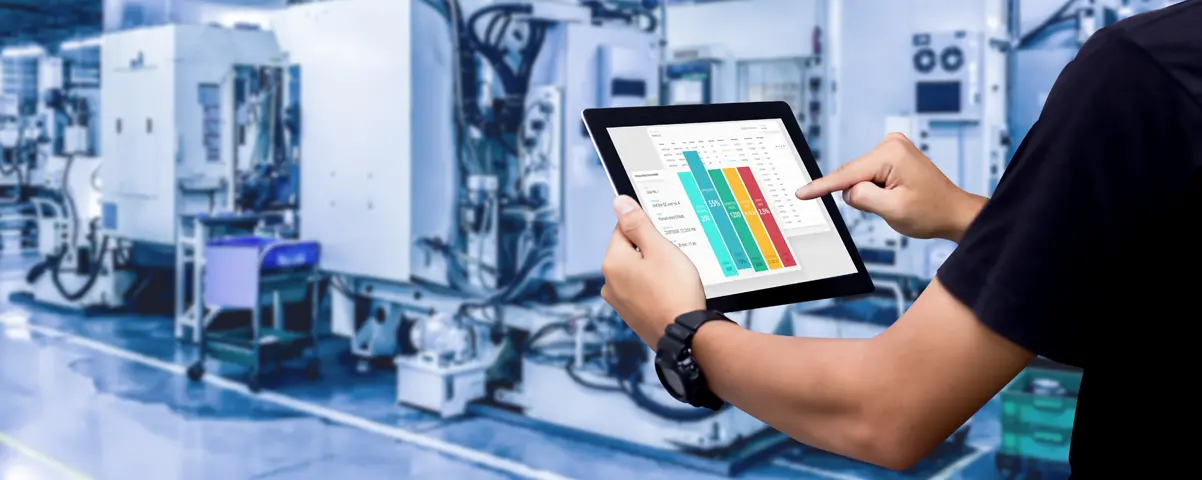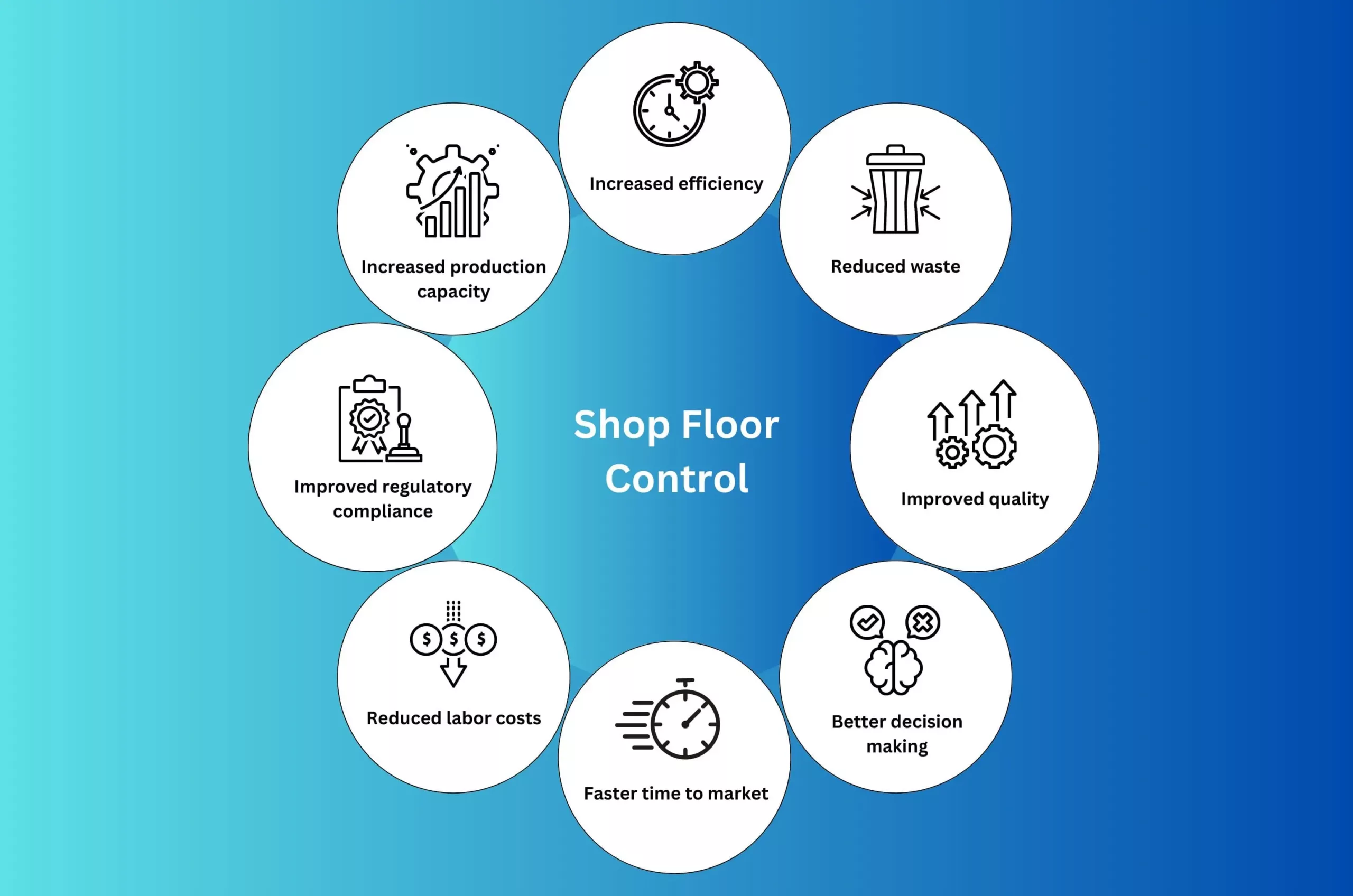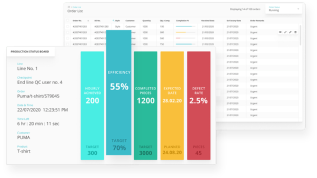Maximizing ROI in Fashion: An Overview of Shop Floor Control Systems
Introduction
Every manufacturing business today knows that that time is money. Every second counts, and every process needs to be optimized for maximum efficiency. This is where Shop Floor Control (SFC) comes in – it’s a crucial tool that helps manufacturers streamline their operations to achieve better ROI.
SFC is the process of managing and controlling the production floor. It involves everything from scheduling production runs and managing inventory to monitoring machines and ensuring quality control. With SFC, factories can gain real-time visibility into their operations, identify inefficiencies, and make data-driven decisions to make their processes more efficient.
In fact, studies show that companies that implement shop floor control can see up to a 30% increase in productivity and up to a 15% reduction in lead times.
But SFC is not a one-size-fits-all solution. There are different phases of SFC, and different systems and technologies that can be used to implement it. It’s important for factory owners to understand their unique needs and goals to choose the right approach.
So, whether you’re a small business or a large enterprise, SFC is a powerful tool that can help you stay competitive in the ever-changing manufacturing landscape. In the following sections, we’ll explore what SFC is, how it can drive ROI, the three phases of SFC, and some examples of popular SFC systems.
What is Shop Floor Control (SFC) in the manufacturing industry?
At its core, Shop Floor Control (SFC) is a method of monitoring and controlling manufacturing operations in real-time to ensure that production goals are met. SFC employs technologies to collect and analyze data from the shop floor, which can then be used to optimize production processes and make data-driven decisions.
To implement SFC effectively, manufacturers must invest in the right technology and processes. This can include the use of sensors, automation tools, SFC software, and other performance optimization tactics to collect and analyze data from the shop floor.
One of the most important aspects of SFC is the collection of data on production processes in real-time. This makes SFC a critical tool for manufacturers looking to improve their bottom line by tracking the flow of materials, managing work schedules, and monitoring equipment performance.
SFC allows businesses to quickly identify and address issues as they arise, reducing the risk of downtime and improving overall efficiency. It can also help manufacturers better manage their inventory, reducing waste and minimizing the risk of stockouts.
What are the 3 Phases of Shop Floor Control in manufacturing?
Shop Floor Control (SFC) involves a series of processes that ensure production runs smoothly and efficiently. These processes can be divided into three main phases: order release, order scheduling, and order progress.
1. Order Release (Planning & Resource Management Phase)
This phase is all about planning and resource management. It begins with the release of an order, which includes information such as the product to be manufactured, the quantity required, and the delivery date. Once the order is released, the planning process begins. This involves determining the resources required to complete the order, including labor, raw materials, and machinery.
Effective planning is crucial for a successful production run. It allows line managers to anticipate and avoid potential problems, such as resource shortages or production delays. SFC software can quickly generate work orders, assign resources, and create a production schedule.
2. Order Scheduling (Production Alignment & Execution Phase)
Once the planning phase is complete, the next step is production alignment and execution. This involves scheduling the resources needed to complete the order and ensuring that they are available when required. The production schedule must take into account factors such as the availability of labor and machinery, as well as any potential production bottlenecks.
SFC software can automatically generate a production schedule based on the resources available and the order requirements. It can also adjust the schedule in real-time if any unexpected issues arise.
3. Order Progress (Monitoring & Control Phase)
The final phase of SFC is monitoring and control which involves tracking the progress of the order and ensuring that it stays on schedule. It also involves identifying and addressing any issues that arise during production, such as quality control problems or equipment failures.
SFC software provides real-time visibility into the production process, allowing manufacturers to identify and address problems quickly. It can also automatically adjust the production schedule if any issues arise, ensuring that the order stays on track.
How does Shop Floor Control help drive ROI in manufacturing?

Shop Floor Control (SFC) is a powerful tool for driving ROI in the manufacturing industry. Here are a few ways in which SFC can help businesses improve their bottom line:
- Increased efficiency: SFC allows the optimization of production processes which reduces downtime so that businesses can achieve higher levels of efficiency and productivity. For example, a study by the National Institute of Standards and Technology found that businesses that implement SFC can improve their productivity by up to 30%.
- Reduced waste: SFC can help businesses better manage their inventory, reducing waste and minimizing the risk of stockouts. The tracking of material usage and implementation of just-in-time inventory management practices helps businesses reduce their production costs.
- Improved quality: SFC helps businesses identify quality issues early in the production process, reducing the risk of defective products and improving customer satisfaction. It lets them monitor equipment performance and collect data on product defects to identify and address quality issues before they lead to product failure.
- Better decision-making: SFC provides businesses with real-time data on their production processes, allowing them to make informed decisions about how to optimize their operations, identify bottlenecks, improve scheduling, and make other changes that can help them achieve higher levels of efficiency and productivity.
- Faster time to market: SFC allows better optimization of production processes, reducing downtime so that businesses can bring new products to market more quickly, giving them a competitive edge.
- Reduced labor costs: SFC can help businesses better manage their workforce, ensuring that employees are working efficiently and effectively. It helps minimize idle time and reduces the need for overtime which leads to reduction in labor costs.
- Improved regulatory compliance: SFC can help businesses ensure compliance with industry regulations and standards. Businesses can demonstrate compliance with regulatory requirements, avoiding costly fines and other penalties through SFC solutions.
- Increased production capacity: With better control over their operations, businesses can scale up their production processes to meet demand. This can include increasing the number of production runs, expanding the range of products produced, or improving the overall speed of production.
These are just a few examples of how Shop Floor Control can help drive ROI in the manufacturing industry.
What are Some Types of Manufacturing Control Systems?
The fashion and garment industry has unique production processes that require specialized Manufacturing Control Systems (MCS) to ensure efficiency and quality. Here are some examples of MCS used in the industry:
- Enterprise Resource Planning (ERP) systems: ERP integrates all aspects of a company’s operations, from production and inventory management to financials and sales orders. In the fashion industry, ERP systems can help manage complex supply chains, optimize production schedules, and monitor inventory levels in real-time.
- Product Lifecycle Management (PLM) systems: PLMs help manage the entire lifecycle of a product, from design and development to production and distribution. In the fashion industry, PLM can help streamline the design process, collaborate more effectively with suppliers, and manage product information and specifications.
- Computer-Aided Design (CAD) software: CAD allows designers to create and modify digital designs, reducing the need for physical prototypes and speeding up the design process. In the fashion industry, CAD software can help designers create more accurate and detailed designs, while also reducing waste and improving sustainability.
- Manufacturing Execution Systems (MES): These systems help manage and monitor production processes in real-time, providing data on key performance metrics and allowing businesses to make informed decisions about how to optimize their operations. In the fashion industry, MES can help reduce lead times, improve quality, and minimize waste.
- Radio Frequency Identification (RFID) technology: RFID uses radio waves to track and identify items in real-time, providing businesses with accurate and up-to-date information on inventory levels and location.
Overall, Manufacturing Control Systems are critical tools for ensuring efficiency and quality in the fashion and garment industry.
Conclusion
Fashion industry is rapidly evolving, and digital transformation is key to staying ahead of the curve. By implementing Manufacturing Control Systems (MCS), businesses can optimize their production processes, reduce waste, and improve overall efficiency and quality. This, in turn, can drive ROI and help businesses gain a competitive edge in the marketplace.
Moreover, digital transformation is also essential for improving sustainability in the fashion industry. MCS can help businesses reduce their environmental impact by minimizing waste and optimizing their use of resources. As consumers become more conscious of sustainability, businesses that prioritize eco-friendly practices will have a distinct advantage.
Ultimately, by embracing digital transformation and investing in the right technology and processes, businesses in the fashion industry can build a more sustainable, efficient, and profitable future. So, let’s embrace the power of digital transformation, and work together to create a better future for the fashion industry and the planet.








